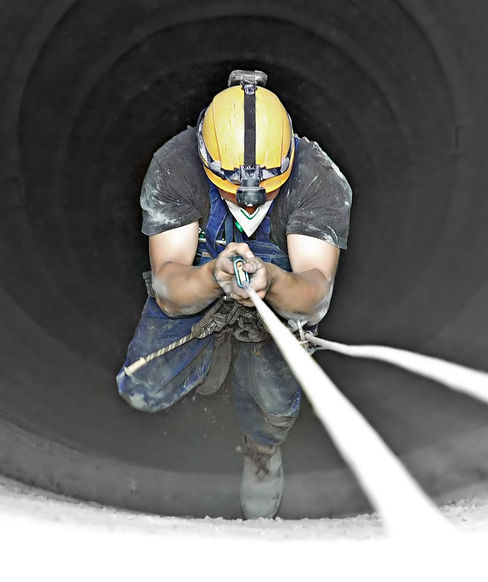24.H Safe Practices for Rope Access Work.
If rope access work is to be performed, a Rope Access Work Plan and accompanying procedures must be developed and submitted to the GDA for acceptance.
24.H.01 Climbing equipment.
- Ropes: Used as working line and safety line must be made of synthetic fiber with a nominal breaking strength of at least 5400 lbs (24 kN) when new. The working lines and safety lines must be specifically designed and intended for life safety use. Additionally, elasticity (elongation) of both lines must be limited to 7% with a load of 540 lbs applied.
- Carabiners and snap hooks: Used for climbing (life support) must have at least two consecutive, deliberate actions to prepare the gate for opening and must be rated at 5,000 lbs (22.2kN) and must meet the ANSI/ASSP Z359 Fall Protection Code. Gates must be rated at 3600 lbs (16 kN). Rope snaps and snap hooks must be self-closing and self-locking. The use of rope thimbles when attaching rope snaps is recommended to prevent rope fraying.
- Pulleys/Rope Sleeves: Anti-friction devices are also recommended to prevent rope damage.
- Rope Blocks/Brakes: Used to make the work safer and requires less hands to control heavy loads. When handling limb removal ropes, ground personnel should not wrap the rope around their hands or waist and keep the rope away from their feet to prevent entanglement.
- Climbers PPE: Appropriate footwear, long pants, work shirt with a minimum 4 in (10.2 cm) sleeve length, eye protection, face shield, hearing protection during chainsaw usage, hard hat with chin strap or ANSI Z89.1 approved climbers helmet (vented or non- vented), and fingerless gloves such as mechanics gloves. When the air temperature exceeds 85 ºF (29 ºC), climbers should carry a water supply with them.
- All equipment must be inspected prior to each use and maintained and used in accordance with manufacturer instructions.
- Employees must be properly trained in the use of all equipment.
- Ropes must not be used to lower limbs or raise equipment.
- Sharp tools such as hand saws must be sheathed when not in use.
- Tools used for de-barking, cavity work, cabling, bark tracing, must be carried in a bag or belt designed for such use, and not carried in pockets or placed in boots.
- Climbers Saddle: Climbers belts/saddles are only meant to be used as a suspension scaffold/equipment. In addition to the saddle a fall arrest system is required. Belts must be equipped with leg straps or seats to take pressure off of the climbers back.
- Climbing ropes must not be spliced to effect repair.
- Ropes must be coiled and piled, or must be suspended, so that air can circulate through the coils to aid in drying.
- Wet ropes must not be used for electrical work.
- Ropes must be inspected before and after each use.
- Harnesses and other personal fall protection equipment used in rope access must meet the ANSI Z359/ASSP Z359, Fall protection Code.
- If descender devices are used, they must allow a controlled descent taking into consideration the weight of the worker, the length of the descent, considerations for safety and the need for stopping along the working line for the purpose of hands free work.
Knowledge Check Choose the best answer for the question.
24-9. What is a requirement for carabiners and snap hooks used for climbing (life support)?
You forgot to answer the question!

